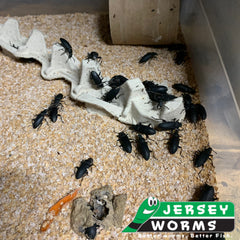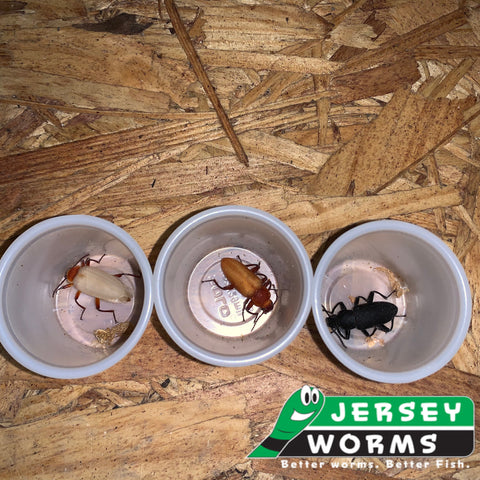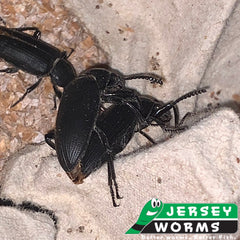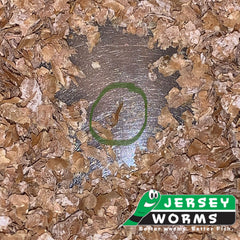Breeding Superworms
I started breeding superworms back when I was 17. I started with supers and other earthworms like the European night crawler and red wigglers. Before I got into the reptile feeder side of business, I personally used them as an awesome source of bait for trout, bass, walleye and more. After tons of research and thousands of cups later, here I am still breeding! Through my journey I have found a few interesting tricks to it that may go unnoticed but still play a key role in caring for or breeding superworms.
How to breed superworms:
Materials you will need (items can be substituted out where necessary):
- Face mask (essential, do not skip this one)
- Rubber gloves
- Superworms
- Deli cups and lids
- A bedding source
- Containers of choice
- Food and water source
Allergies when breeding superworms:
First and foremost, I want to inform you that breeding superworms may cause some unwanted side effects. The biggest downfall is personal health. I highly recommend that you purchase a face mask at your local mom and pop store (support small businesses!). When breeding super worms, dust fills the air during harvesting or pouring in new bedding. This may not affect everyone, but some may develop an allergy right away or months into the breeding process. Using a face mask and gloves can help reduce the chance of developing an allergy to the superworms. Keeping clean air by using air purifiers or opening windows is also a great way to remove dust and reduce the smell.
Isolating superworms for breeding:
Super worms are cannibalistic. Because of this, when super worms are in a communal setting, they will not morph into a pupa. Superworms turn into pupa and then pupa turn into darkling beetles which then reproduce and lay eggs which hatch into superworms, starting the entire process over again. One of the most difficult parts of breeding superworms is getting them to morph into a pupa. Superworms need to be isolated completely in order to morph into a pupa. Meaning that they cannot have access to any other animals, food or water. This can take anywhere from 7-21 days. It is important to keep in mind that not all superworms that you isolate will pupate. There are many different factors that go into pupating. One of the main reasons that a superworm will not pupate is because it is not old enough yet. Film canisters, condiment cups and tackle boxes are the most commonly used products to isolate the superworms. Place one superworm per container and then leave them alone and hope that they pupate!
What to do once superworms have been isolated:
Once you have isolated your superworms, you can either leave them in room temperature or a warmer climate. The ideal temperature to keep your superworms is anywhere between 75-82 degrees fahrenheit. Keeping them at a slightly lower temperature will not necessarily harm them, they may not grow/reproduce as quickly. Once they are isolated, it is key to not disturb them much. I have found best results when checking them after about 15-21 days since they were isolated. When you go to check your superworms you will most likely find a combination of pupa, “curled” superworms, dead superworms and superworms that have not changed. When you find the superworms that have pupated, you can remove them from isolation and place them in a clean bin with clean bedding in it. Then wait another 7-14 days for the pupa to morph into a beetle. Superworms that are “curled” are ready to pupate in a few days, leave them in the cup and check them a few days later. Superworms that have not changed should be removed and placed in a bin that will allow them to grow older to be fed off or isolated again. Dead superworms should be discarded. Once the pupa’s begin to morph into beetles, make sure to start feeding them fruits and vegetables which are a good source of water and nutrition. Some ideal fruits and vegetables include apples, potatoes, and carrots.
What to do with your darkling beetles:
To ensure for the most amount of reproduction it is essential that the beetles have enough food, water and are in a good environment. I keep my beetles in a 6 gallon sterilite container that is filled about 1.5inches full of wheat bran bedding material. I then provide areas for them to climb on and hide in such as toilet paper rolls or small pieces of egg crates. I have found that they enjoy spending most of their time in these areas. Like I stated previously, they like to be in a warmer climate with little light. Each female beetle is expected to lay approximately 500 eggs. It is ideal to harvest the bedding for eggs every 2-4weeks. Take a 1/16 inch screen and sift through the bedding. Transfer the “old” bedding into a new container and place the beetles back into their container with new bedding to start laying eggs again. After about one month you will start to see movement in the bedding that you harvested. The eggs will hatch in this environment and you will begin to see very tiny superworms. Once this has occurred it is important to provide them with very small amounts of food.

Looking for starter superworms? Click here
Have something to contribute? Or want to share your set up? Comment below!
Sample Block Quote
Praesent vestibulum congue tellus at fringilla. Curabitur vitae semper sem, eu convallis est. Cras felis nunc commodo loremous convallis vitae interdum non nisl. Maecenas ac est sit amet augue pharetra convallis nec danos.
Sample Paragraph Text
Praesent vestibulum congue tellus at fringilla. Curabitur vitae semper sem, eu convallis est. Cras felis nunc commodo eu convallis vitae interdum non nisl. Maecenas ac est sit amet augue pharetra convallis nec danos dui.
Cras suscipit quam et turpis eleifend vitae malesuada magna congue. Damus id ullamcorper neque. Sed vitae mi a mi pretium aliquet ac sed elitos. Pellentesque nulla eros accumsan quis justo at tincidunt lobortis denimes loremous. Suspendisse vestibulum lectus in lectus volutpat, ut dapibus purus pulvinar. Vestibulum sit amet auctor ipsum.










This is the reply to Lois’ comment above that I emailed her.
Hi, This is Gavin from Jersey Worms. I got your comment under my Super Worm blog and I just wanted to get back to you. Since I cannot directly reply, I am not sure if you got the message. Therefore, I am emailing you in case you do not see this reply. It is very hard to keep them alive when going on vacation. Best options are to find fruits or veggies that will hold water the longest. I would suggest Potatoes. I would slice them into 4 pieces and place the skin side downward. This will prevent the moisture from molding the bedding. Add enough to keep them fed for 4 days. It will be very difficult to add more without the potatoes and/or the bedding starting to rot. First thing you do when you get home would be to replace the food. As an additional step, you can place it on a paper towel in case it does leak a little, you can use the paper towel to soak the extra water up.
How can I go on vacation for 9 days and keep my 900 adult super worms alive? What moisture can I put in there? I put sliced potato in there every few days for moisture. What can I do for 9 days?
I am in Australia and had no idea that the collection of castings form super worms could be so complex. But I guess that all worthwhile products required some learning and some effort.
My interest is in the use of castings of best quality used in my testing of mixes best for seedlings. I would like to embark on a program that allowed me to provide my own homemade castings.
The description of the process was most interesting. Thank you.
Rex Williams
So glad that I found this page. I am trying to raise some super worms ( fishing ) and mealy worms for my chickens to eat. I started out with 200 mealy and 50 super worms but unfortunately we just had a rare winter storm and our lights went out for 5 days . Most of my super worms die, I manage to save 4 super worms ; hopefully I get some females and males and not all the same sex; will know in time. Mealy worms, I have 51 beetles left.
Looking forward to follow your steps to maximize my production.
Great info guys! Thanks for sharing.